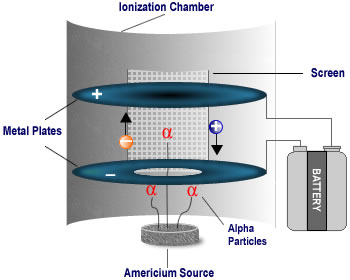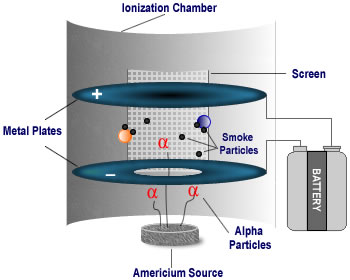Ionization Technology
Smoke Detectors
Ionization sensor smoke alarms contain a small amount of radioactive material, americium embedded in a gold foil matrix within an ionization chamber. The matrix is made by rolling gold and americium oxide ingots together to form a foil approximately one micrometer thick. This thin gold-americium foil is then sandwiched between a thicker (~0.25 millimeter) silver backing and a 2 micron thick palladium laminate. This is thick enough to completely retain the radioactive material, but thin enough to allow the alpha particles to pass.
The ionization chamber is basically two metal plates a small distance apart. One of the plates carries a positive charge, the other a negative charge. Between the two plates, air molecules-made up mostly of oxygen and nitrogen atoms-are ionized when electrons are kicked out of the molecules by alpha particles from the radioactive material (alpha particles are big and heavy compared to electrons). The result is oxygen and nitrogen atoms that are positively charged because they are short one electron; the free electrons are negatively charged.
The diagrams below illustrate how ionization technology works. The positive atoms flow toward the negative plate, as the negative electrons flow toward the positive plate. The movement of the electrons registers as a small but steady flow of current. When smoke enters the ionization chamber, the current is disrupted as the smoke particles attach to the charged ions and restore them to a neutral electrical state. This reduces the flow of electricity between the two plates in the ionization chamber. When the electric current drops below a certain threshold, the alarm is triggered.
| Alpha particles from the americium source ionize air molecules |
 |
| In the smoke-free chamber, positive and negative ions create a small current as they migrate to charged plates |
| Smoke particles and combustion gases interact with the ions generated by the alpha particles, restoring them to their neutral electronic state and decreasing the electrical current passing through the cell. |
 |
| As fewer ions are available to migrate to the plates, the disrupted current triggers the alarm |
![[logo] US EPA](https://webarchive.library.unt.edu/eot2008/20090508081916im_/http://www.epa.gov/epafiles/images/logo_epaseal.gif)